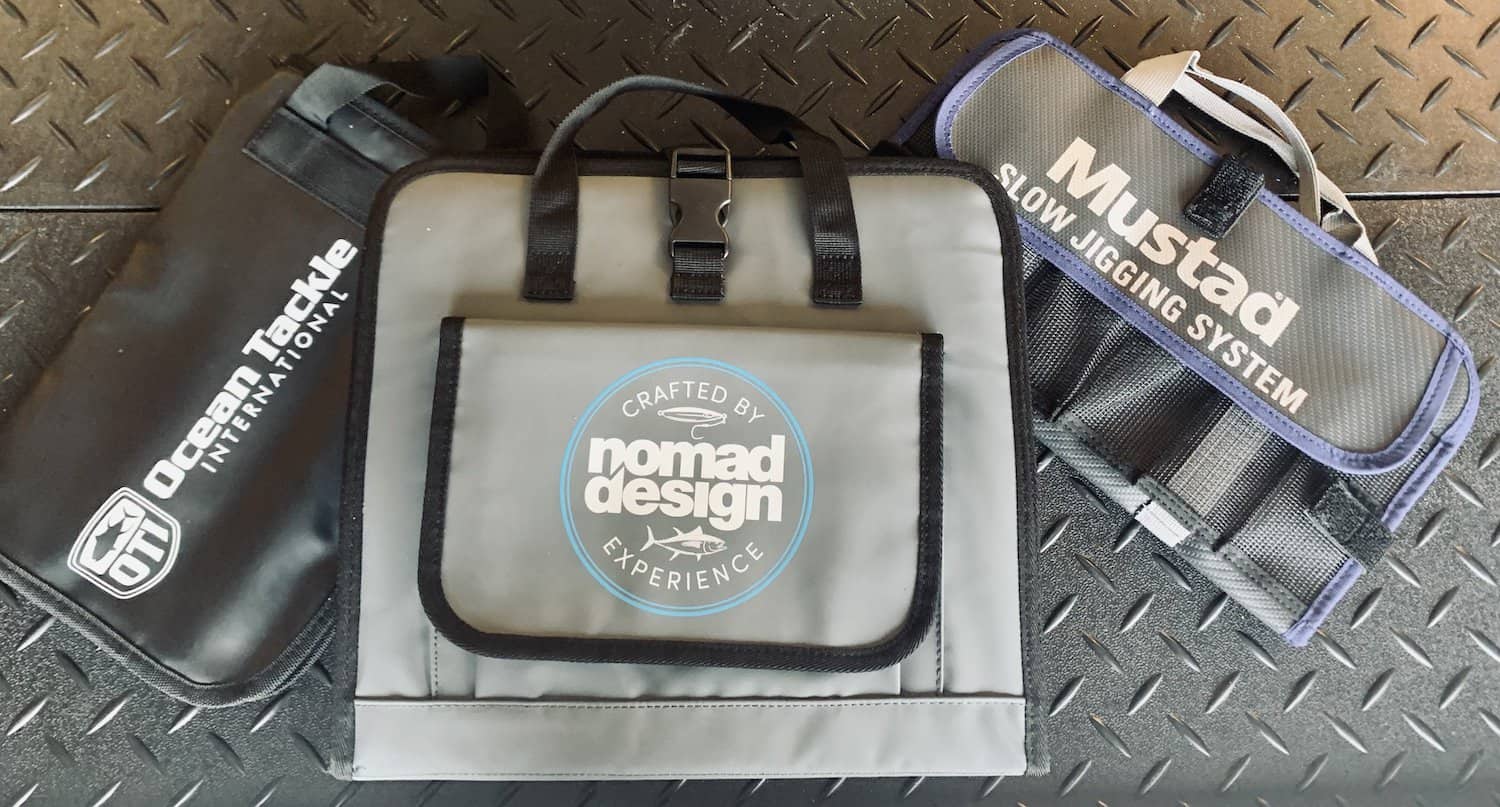If you’re interested in saltwater jigging, speed or slow pitch, you have likely acquired a large quantity and variety of jigs. I started off using those plastic storage bins, but I can’t help but hate them. The good news is, there are plenty of great storage solutions on the market and I’ve rounded up the best ones here.
You Must Buy the Nomad Jig Wallet & Insert
This might sound crazy, but I was really excited to buy the Nomad jig wallet and insert. When I looked at it online, it seemed like it was heavy duty material to last for a long time, and it has more features than a lot of the competing bags.
The front pocket is great for storing extra assist hooks. It's a large vinyl pocket with a Velcro closure. I like how the pocket expands out when you open it. It makes it easier for me to see what I’m grabbing out of it. The front of the pocket has the Nomad Design logo and it looks nice on the dark gray heavy duty vinyl.
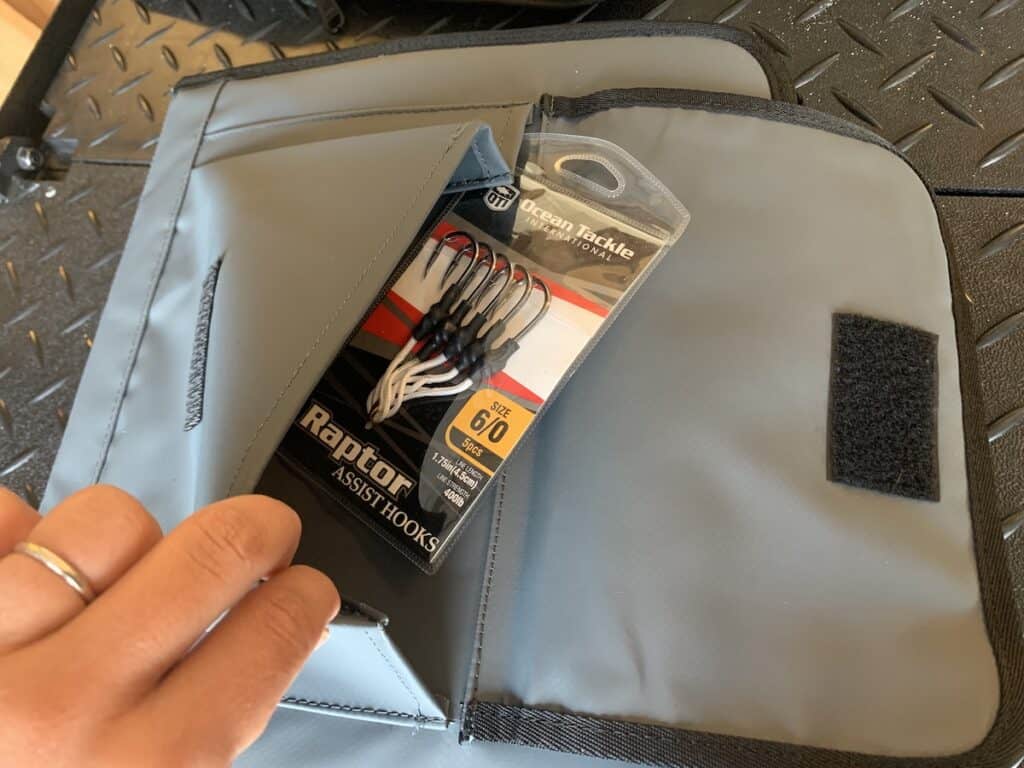
When putting your jigs in the pockets and the hook mesh, you secure them even further by closing a vinyl flap with a Velcro closure. With the hook mesh, the fact that the wallet is held upright, and the vinyl flap on top of the jigs, I know there’s no way a jig would fall out of the wallet. I’m grateful for the extra security since I already have to replace enough jigs that get bit off! There’s also plenty of room in the pockets to store your leader line with the jig if you have some pre-rigged jigs.
I bought this wallet initially thinking I would store my slow jigs, fast jigs, and maybe even a popper or crankbait. I quickly realized when I received it that there’s no way a popper or crankbait can even get in the pockets because the hooks would get caught on the hook mesh. This shouldn’t be an issue for slow jigs or fast jigs, unless you plan to store them with assist hooks on both sides. It’s much more common to see only one or two assist hooks on the top end of the lure and the bottom eyelet is usually empty. And don’t worry—Nomad makes a nice lure roll bag for poppers and crankbaits and it has vinyl pockets, instead of mesh pockets.
I will say that it can be a challenge to get some hooks through the mesh. I’ve noticed that the mesh holes are so small that the stock hook on my Nomad Buffalo Jig 230g can’t fit in the hole. It seems like the barb on the hook is the main reason it won’t fit. The way I’m handling it is simply poking the tip of the hook through the mesh, instead of a larger portion of the hook. I tried pretty hard to push it through and the mesh wouldn’t break, which says good things about the durability of the mesh.
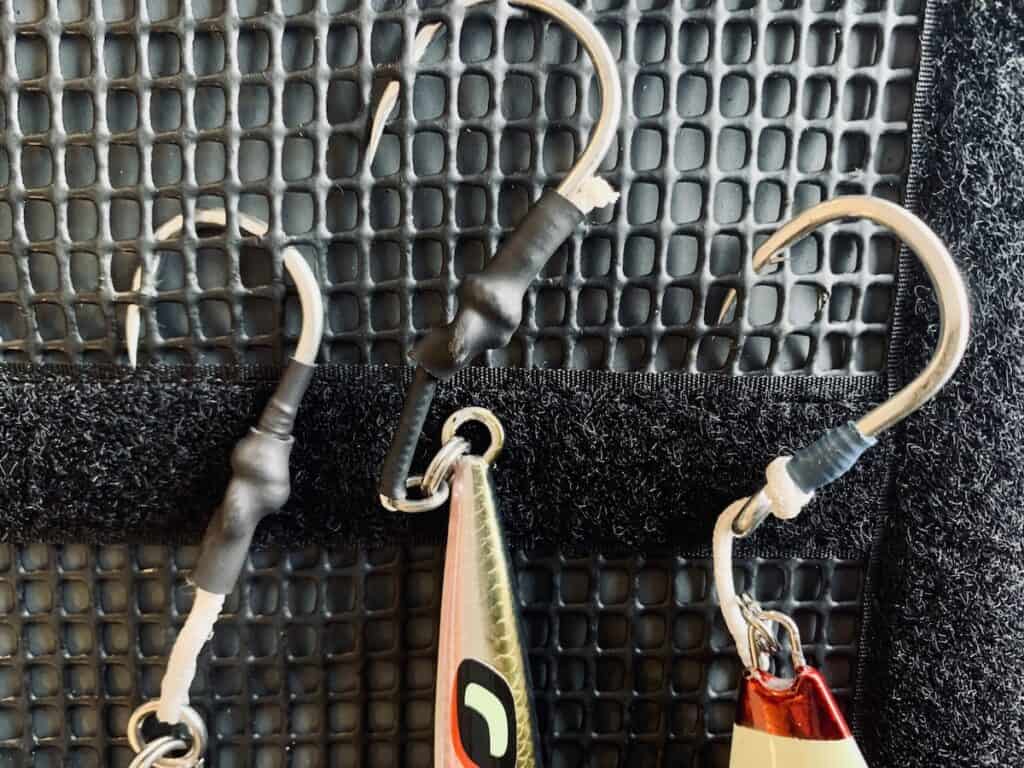
The jig wallet is also expandable. You can buy the insert separately and it’s a nice way to add storage capacity. The insert itself can hold up to 24 large jigs (320g) and 48 small jigs (80g). The insert sleeve attaches to the main jig wallet by a strip of heavy duty Velcro. When attached, it’s easy to flip the sleeve back and forth like pages in a book. I like how the insert gives me a cohesive storage solution for my jigs, and when I want to go out on a trip, I’ll usually only pack the size jigs I want and leave the insert full of my other jigs at home. This is a great way to lighten up your load for the day.
I also like that the bag doesn’t have any metal on it at all. It should last for years with no rust or dried salt clogging up a zipper or anything. The closure mechanism is a plastic buckle, like you see on life jackets. This makes it easy to open and close. There is another portion of vinyl and Velcro on the top of one of the handles which allows you to seal both handles together temporarily. It's a nice touch that makes it feel nicer when you carry it. The design team at Nomad really though about everything with this bag!
The Ocean Tackle International Jig Kit is a Great Value
Another jig bag on the market is by Ocean Tackle International. What I love most about this bag is that it comes as a kit, full of jigs. There are three different options: a small kit with 6 traditional jigs, a medium kit with 7 slow jigs, and a large kit with 10 slow and fast jigs!
All three options come with the same sized bag, the Ocean Tackle Extreme bag. I purchased the medium sized kit when I was getting setup with my slow jigging rod, reel, line, and jigs.
The bag is made of vinyl and has hook mesh pockets for storing jigs. The mesh is a smaller sized mesh than the Nomad bag, which means you’ll only be sticking the point of the hook in the mesh. It hasn’t been an issue for me since the hooks are staying put really well. I like that the bag is smaller in size than the Nomad bag, but they smartly chose to layer the pockets to maximize the capacity. The pockets on the back layer are longer, so you can store your long, 300+ gram fast drop lures in them. Sometimes its not that easy to put the hooks in the hook mesh. Since the hook tip points parallel to the shaft, or slightly toward the shaft, you have to get your fingers in the mesh pockets to sort of, pick up the mesh and stick the hook in. I’ve stuck myself a few times already, but no bleeding yet, ha!
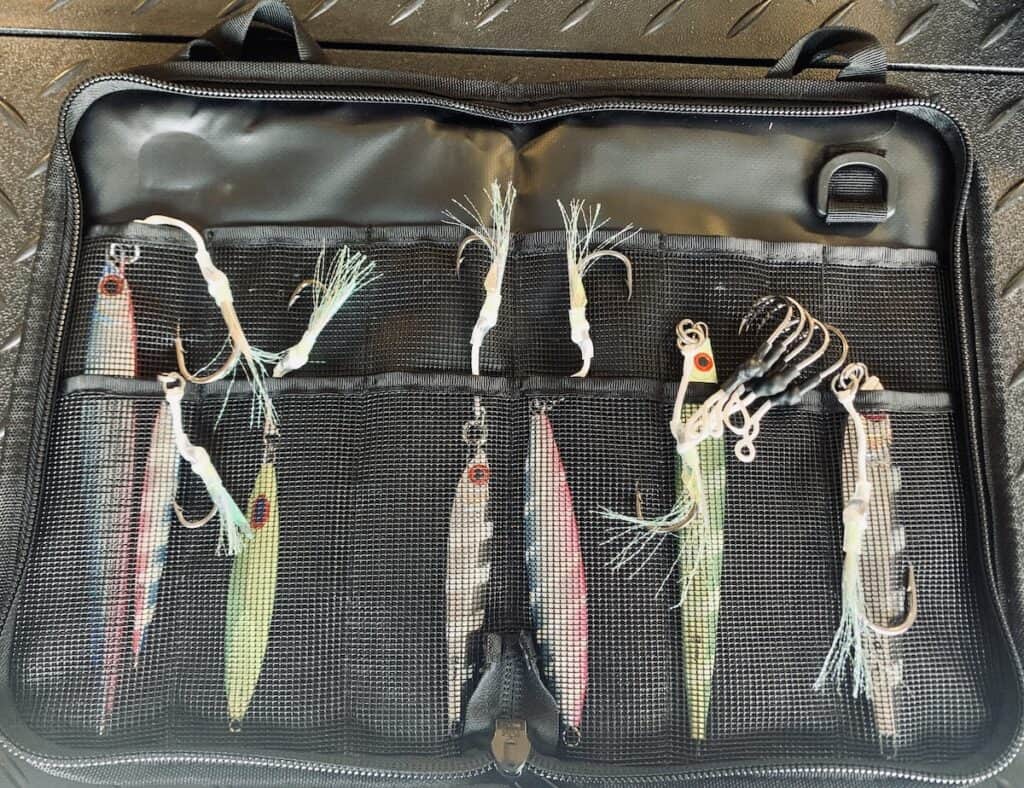
The bag has a plastic D ring on the inside which is nice for clipping on your split ring pliers. Jigs are rigged with split rings to make swapping jigs easier. You’ll definitely need a pair of split ring pliers while you’re out on the water jigging, and what better place to store them than inside the bag with your lures?
The outside of the bag has two mesh pockets. I find this design choice to be helpful for storing leader line, but not helpful for storing extra assist hooks. I ended up opening the bag and sticking my assist hooks directly in the hook mesh to store them. It works well, but it makes me open the bag with caution to make sure my spare hooks don’t fall out.
The bag closes with a plastic zipper. So far, the zipper is holding up well, but I’m not sure how it’ll do when things start getting salty.
I like how you open the bag and you can immediately see all of the lures. There’s no additional step to open up a flap and they’re still plenty secure because of the mesh and the zipper closure. It does mean that you have to be careful when opening, though. I’ve noticed that if I open the bag from the bottom corner, the jigs want to slide out of the pocket. I would recommend opening it from the mid point, or the top corner of the bag, to avoid jigs sliding out.
When it comes time to clean your lures after a day of jigging, simply open the bag, spray it down with freshwater and hang it to dry (with the jigs in it)! The water will drain through the mesh and the vinyl will repel the water. Cleaning up always seems to take so much time, so I’m always happy to see products that keep clean up simple.
Overall, I’m happy with the size of this bag. It has a lot of storage space and a compact profile. It feels easy to carry and doesn’t take up too much space in the truck on the way to the boat, or on the boat. Although it can get heavy when you pile a bunch of jigs in it, it seems like it would be pretty easy for a kid to carry it without being overwhelmed by the size.
Why You’ll Worry About Losing Jigs in the Mustad Jig Bag
The Mustad Jig Bag is about the same size as the OTI bag, but its organized very differently. When you first look at the bags, the biggest difference that makes the Mustad bag stand out is that there are jig pockets directly on the outside of the bag. The pockets are made with hook mesh, similar to the other two jig bags. There is a vinyl and Velcro flap over the top of the pockets on both external sides of the bag. The Mustad flap seems the least secure of all of them. The OTI bag has a zipper that goes all around to make sure no jigs can fall out, the Nomad jig wallet has Velcro that seals all around the jig pockets, but the Mustad bag only has two 2 inch strips of Velcro to seal in six jigs on each of the external sides. Its very possible to see a jig slide out of the pocket, especially since the hook mesh is just as fine as the OTI bag mesh and it’ll be tough to get much of the hook in the mesh.
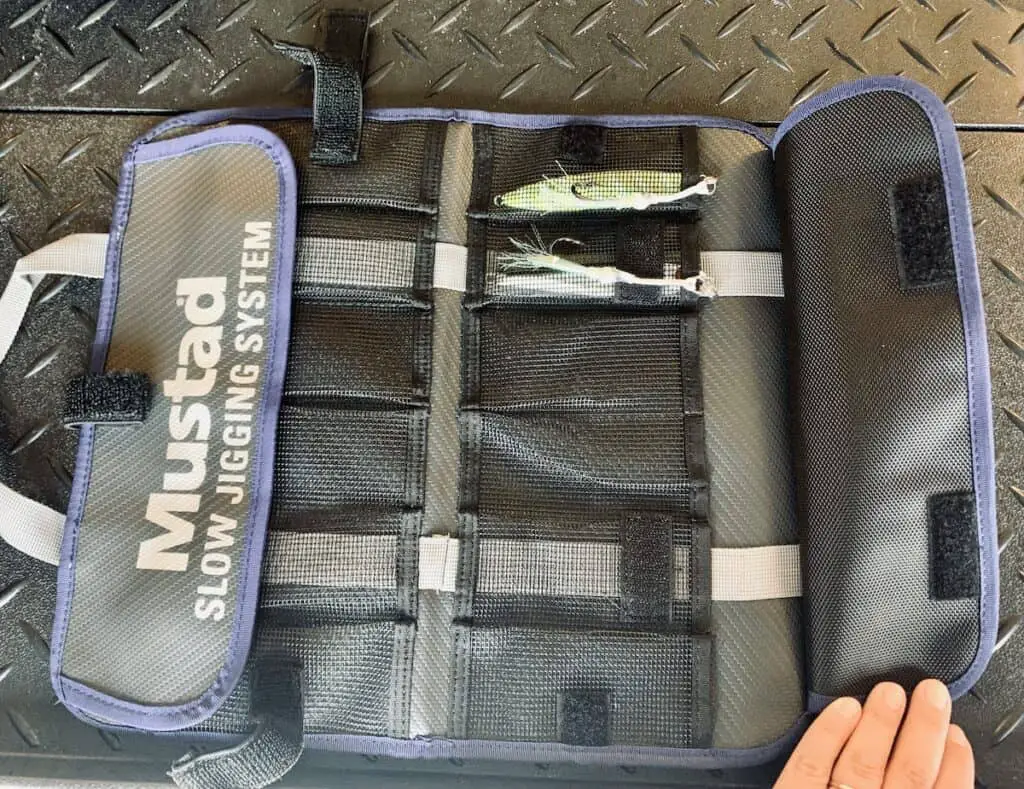
Opening the bag is not a pleasant experience. There are 3 different Velcro straps to undo to open and get to the jigs on the inside. Each of these 3 Velcro straps, has a second strap right next to it that you use when you flip the bag inside out. The bag is reversible, so you can choose which side to expose to the exterior.
On the inside, you’ll see two different sides. One is labeled “light jigging system” and has 10 narrow pockets for slender and light jigs. The opposite side is labeled “jigging accessories” and consists of 2 large mesh pockets for leaders and spare assist hooks. Again, the flaps on these two sides that are meant to secure the jigs and accessories only have two 2 inch strips of Velcro securing down the equipment. I’d surely lose some jigs out the side of the Mustad bag.
Similar to the other two bags, its designed without any metal and designed to be able to rinse off and dry after a day of fishing. Every pocket is mesh, so there’s no chance of getting trapped water.
The Nomad Jig Wallet & Insert and OTI Jig Kits Are Keepers
When it comes to jig bags, sometimes you need something small and light, and sometimes you want something that keeps a large quantity nicely organized. The only bag I really don’t like is the Mustad bag, so I’ll be returning it. The Nomad jig wallet is fantastic, but I could see myself wanting something smaller if I were going out on a short trip or something. My plan is to keep all of my offshore jigs in the Nomad jig wallet, and keep my inshore jigs in the OTI bag. That way, I should be able to grab the smaller OTI bag when I’m going to do some jigging inshore, and bring the full Nomad jig wallet when jigging offshore. Although I would still want to bring a good variety of jigs with me inshore, the OTI bag has surprisingly large capacity to store everything I should need. I will also pick up the 6 inch Shimano Power Pliers and keep them in the OTI jig bag, and put a pair of 7 inch Shimano Power Pliers in the Nomad Jig wallet. I like to store my things as close to “ready to go” as I can.
The Nomad bag is the only one that has a pocket without the hook mesh. I find this to be so important for storing spare assist hooks. I prefer to keep spare hooks in some sort of small bag and then put them in this pocket. The mesh pockets on the OTI bag and the Mustad bag would make it so difficult to get the hooks out of the pockets, and they’re so tight that I simply don’t have the room to put the hooks in a bag first.
I hope this article helps you narrow down what jig bag to choose. While you’re here, I’ve done several articles on jigging that you should check out.
Top 5 Butterfly Jigs: How to Use them & Why You Need Them
How I Chose My Slow Pitch Jigging Rod, Reel, & Jigs
Why Some Anglers Prefer Spinning Tackle for Jigging
Tight lines, y’all!
Recent Posts
Fat Cow Jig Strips: The Ultimate Bucktail Jig Upgrade for Surf Fishing
As discussed in my previous article, "Surf Fishing with Bucktail Jigs: Ultimate Guide for Beach Anglers," bucktail jigs are a staple in any surf angler's tackle box, offering a versatile way to catch...
In my previous article, "Surf Fishing with Bucktail Jigs: Ultimate Guide for Beach Anglers," I introduced you to the bucktail jig and discussed how versatile of a lure it is for catching a wide range...

